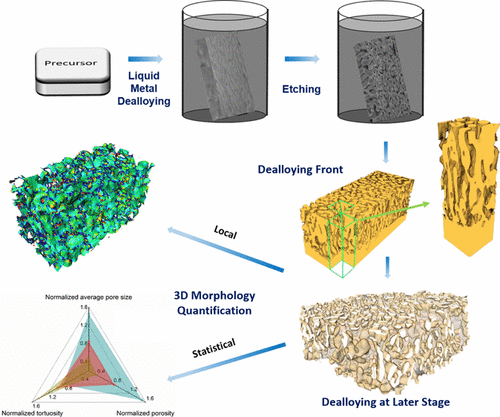当前位置:
X-MOL 学术
›
ACS Appl. Mater. Interfaces
›
论文详情
Our official English website, www.x-mol.net, welcomes your
feedback! (Note: you will need to create a separate account there.)
Three-Dimensional Morphological and Chemical Evolution of Nanoporous Stainless Steel by Liquid Metal Dealloying
ACS Applied Materials & Interfaces ( IF 8.3 ) Pub Date : 2017-09-19 00:00:00 , DOI: 10.1021/acsami.7b04659 Chonghang Zhao 1 , Takeshi Wada 2 , Vincent De Andrade 3 , Garth J. Williams 4 , Jeff Gelb 5 , Li Li 4 , Juergen Thieme 4 , Hidemi Kato 2 , Yu-chen Karen Chen-Wiegart 1, 4
ACS Applied Materials & Interfaces ( IF 8.3 ) Pub Date : 2017-09-19 00:00:00 , DOI: 10.1021/acsami.7b04659 Chonghang Zhao 1 , Takeshi Wada 2 , Vincent De Andrade 3 , Garth J. Williams 4 , Jeff Gelb 5 , Li Li 4 , Juergen Thieme 4 , Hidemi Kato 2 , Yu-chen Karen Chen-Wiegart 1, 4
Affiliation

|
Nanoporous materials, especially those fabricated by liquid metal dealloying processes, possess great potential in a wide range of applications due to their high surface area, bicontinuous structure with both open pores for transport and solid phase for conductivity or support, and low material cost. Here, we used X-ray nanotomography and X-ray fluorescence microscopy to reveal the three-dimensional (3D) morphology and elemental distribution within materials. Focusing on nanoporous stainless steel, we evaluated the 3D morphology of the dealloying front and established a quantitative processing–structure–property relationship at a later stage of dealloying. The morphological differences of samples created by liquid metal dealloying and aqueous dealloying methods were also discussed. We concluded that it is particularly important to consider the dealloying, coarsening, and densification mechanisms in influencing the performance-determining, critical 3D parameters, such as tortuosity, pore size, porosity, curvature, and interfacial shape.
中文翻译:

液态金属脱合金对纳米多孔不锈钢的三维形态和化学演化
纳米多孔材料,特别是通过液态金属脱合金工艺制造的纳米多孔材料,由于其高表面积,双连续结构(既具有用于运输的开口孔又具有用于导电性或支撑的固相的双连续结构)以及较低的材料成本,在广泛的应用领域中具有巨大的潜力。在这里,我们使用X射线纳米断层扫描和X射线荧光显微镜检查来揭示材料中的三维(3D)形态和元素分布。着眼于纳米多孔不锈钢,我们评估了脱合金前端的3D形态,并在脱合金后期建立了定量的加工-结构-性能关系。还讨论了通过液态金属脱合金和水性脱合金方法产生的样品的形态差异。
更新日期:2017-09-19
中文翻译:

液态金属脱合金对纳米多孔不锈钢的三维形态和化学演化
纳米多孔材料,特别是通过液态金属脱合金工艺制造的纳米多孔材料,由于其高表面积,双连续结构(既具有用于运输的开口孔又具有用于导电性或支撑的固相的双连续结构)以及较低的材料成本,在广泛的应用领域中具有巨大的潜力。在这里,我们使用X射线纳米断层扫描和X射线荧光显微镜检查来揭示材料中的三维(3D)形态和元素分布。着眼于纳米多孔不锈钢,我们评估了脱合金前端的3D形态,并在脱合金后期建立了定量的加工-结构-性能关系。还讨论了通过液态金属脱合金和水性脱合金方法产生的样品的形态差异。











































 京公网安备 11010802027423号
京公网安备 11010802027423号